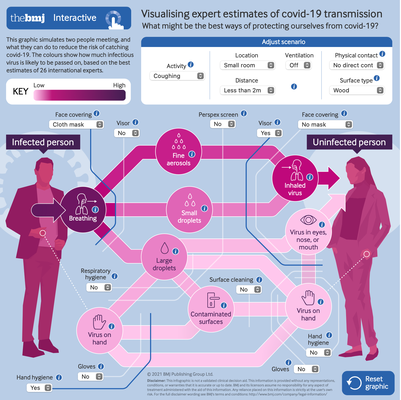Winton Centre for Risk and Evidence Communication
News - How risky is it? A new interactive tool to help people see the different routes of Covid-19 transmission in different situations

Click here to use the tool itself.
The tool is based on knowledge distilled from 26 international experts with different areas of expertise, brought together into a single graphical form which is designed to help illustrate the risks of catching Covid-19 in different scenarios - and what can be done to reduce those risks. We hope that it will help everyone make informed decisions about the relative risks in different situations, and what they might do to help protect themselves and others.
As co-author Harry Rutter at the University of Bath says: “It is all too easy to focus on just a single route of spread for covid and forget about all the others. One of the ways a tool like this can help is by making it really clear that all the transmission routes matter, in different proportions in different contexts. The fact that one of those routes - airborne transmission - is the main one in most situations doesn’t mean that we can ignore the others.”
To create the tool took the collaboration those who know about Covid-19 from many different viewpoints, expertise in evidence communication, and in graphic design.
Author Simon Parker from the Defence Science and Technology Laboratory adds: “One of the real strengths of this approach is that is allows the many complexities of virus transmission to be combined in an integrated way. It provides a system level view of the individual-to-individual transmission. The interactive tool allows people to explore how the different factors influence the component parts and also the overall strength of transmission.”
A piece describing the development of the tool is published in the BMJ here, and there is more about the findings here.